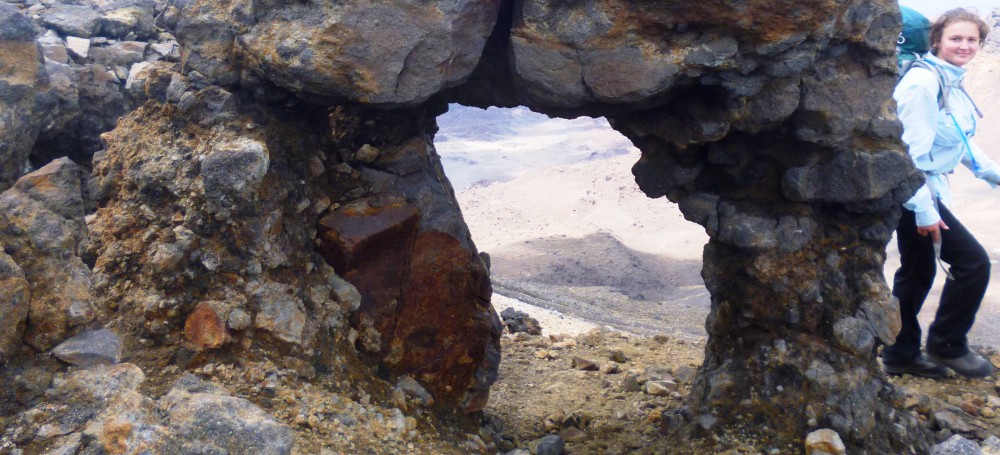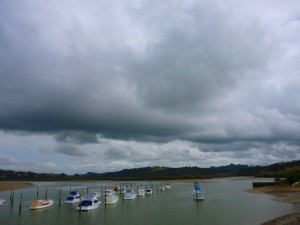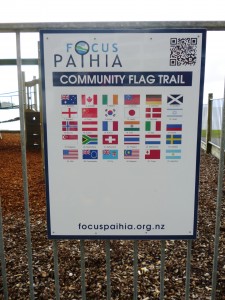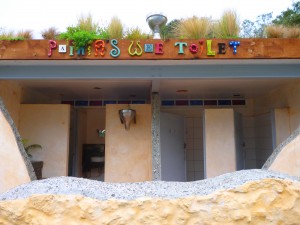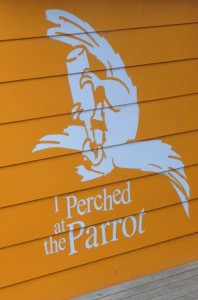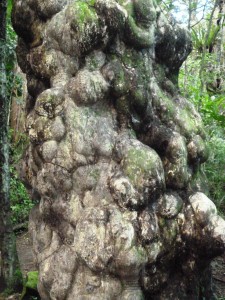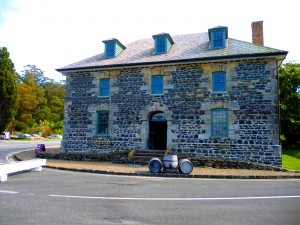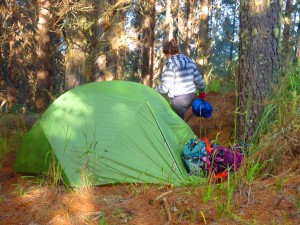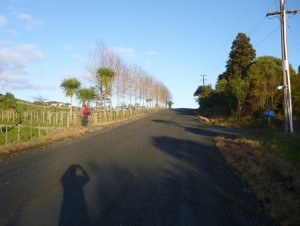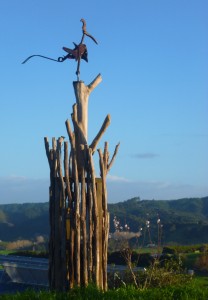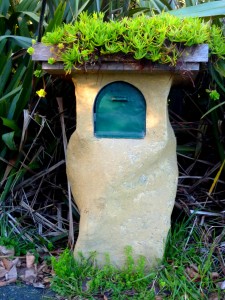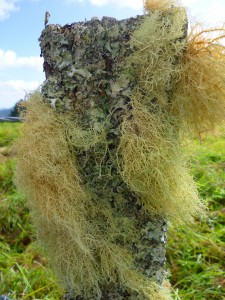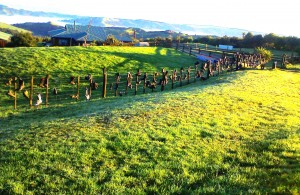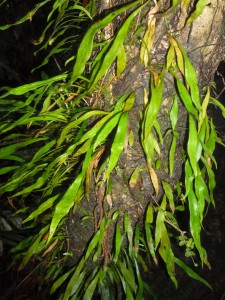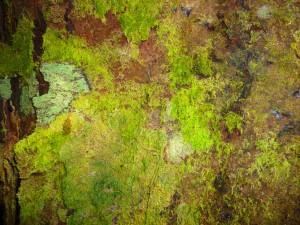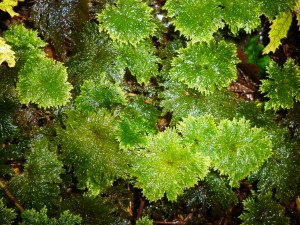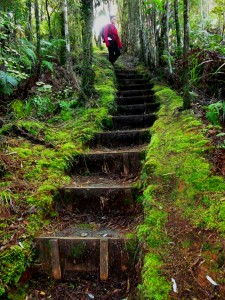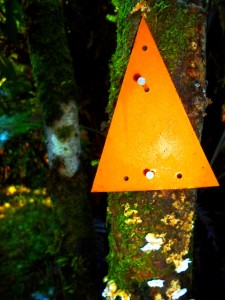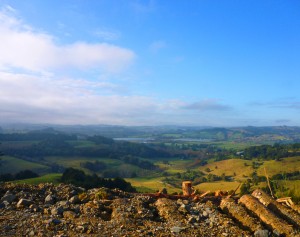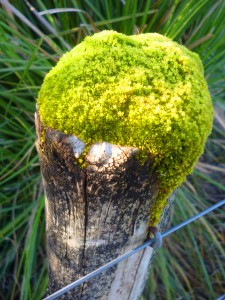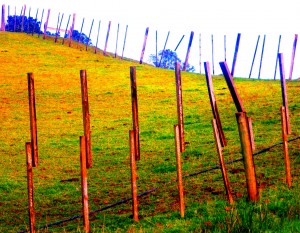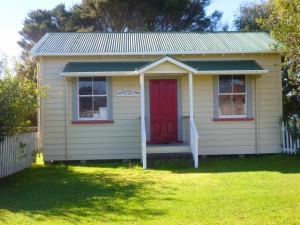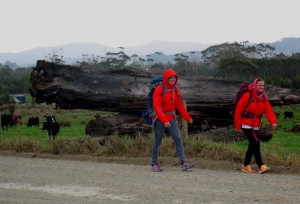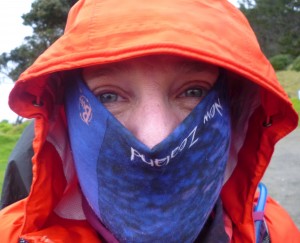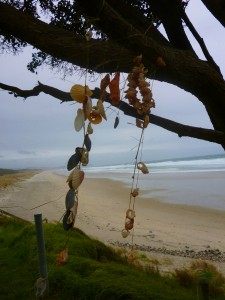102 km
Thursday 18 July
Cape Reinga to Twilight Beach (10 km)
We arrived at Cape Reinga at midday. This spot is the furthest North in NZ that you can go without seeing a polar bear. When you get there, you still won’t see a polar bear. At the lighthouse we posed under the multi-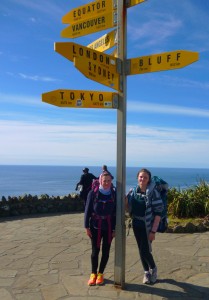 directional sign that informed us exactly where we weren’t and indicated how far we’d have to swim to get to the equator. There was rather a crowd at the lighthouse, as three tour buses had just disgorged their swarming contents. We preened a little, as the only numpties carrying backpacks.
directional sign that informed us exactly where we weren’t and indicated how far we’d have to swim to get to the equator. There was rather a crowd at the lighthouse, as three tour buses had just disgorged their swarming contents. We preened a little, as the only numpties carrying backpacks.
We posed again in a few other places. Gosh, do you know how easy it is to ponce around posing for something you aren’t sure you’re going to do yet? It is a bit like using a calligraphic pen to make a list of what you’re going to buy when you win the Lotto.
Here we are at the start of the trail. This annoying camera auto-focuses on the middle distance, not on the subject in the foreground, so the full horror of my tramper’s headgear (it’s a “buff”)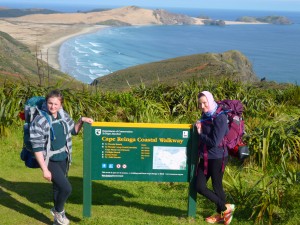 is mercifully blurred.The first trail marker is behind the green DOC sign. It is a post, painted orange. These posts and orange triangles mark the rural trail aaaaall the way to the southernmost tip of South Island. I did not know this when I bought my shoes. However, matching walking shoes and trail markers must be a good sign. When Geographical
is mercifully blurred.The first trail marker is behind the green DOC sign. It is a post, painted orange. These posts and orange triangles mark the rural trail aaaaall the way to the southernmost tip of South Island. I did not know this when I bought my shoes. However, matching walking shoes and trail markers must be a good sign. When Geographical 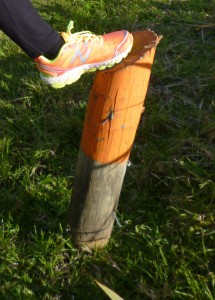 Positioning and Sartorial X-Factor are aligned, you experience a premonition, a frisson of certainty from the heavenlies that you’re not going to put a foot wrong. People in the street have laughed at my shoes. Openly, I tell you, openly! God will punish them.
Positioning and Sartorial X-Factor are aligned, you experience a premonition, a frisson of certainty from the heavenlies that you’re not going to put a foot wrong. People in the street have laughed at my shoes. Openly, I tell you, openly! God will punish them.
We hugged and kissed Marius, Etienne and Zoë goodbye and began our descent. When we reached Te Werahi Beach, Hannah filled a 200 mL bottle with sea water and put it in her pack. This bottle is called “The Thing” and the water in it represents what people recovering from mental illness carry. Hannah suffers from depression, anxiety and a compulsion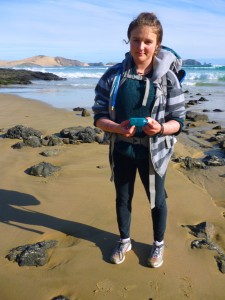 to harm herself. For others, the thing might be post-traumatic stress disorder, the confusion of senile dementia, or simply a feeling of emptiness which nothing can fill. Hannah will be the bearer of the thing. When we reach the southernmost tip of South Island, or whatever the end point of our journey is going to be, we shall empty the bottle into the sea or onto the ground, symbolically throwing out sadness and distress for everyone who has suffered mental illness.
to harm herself. For others, the thing might be post-traumatic stress disorder, the confusion of senile dementia, or simply a feeling of emptiness which nothing can fill. Hannah will be the bearer of the thing. When we reach the southernmost tip of South Island, or whatever the end point of our journey is going to be, we shall empty the bottle into the sea or onto the ground, symbolically throwing out sadness and distress for everyone who has suffered mental illness.
We walked westwards towards Herangi Hill, a euphemism for a massive orange dune. Less than 5 km into our epic journey, 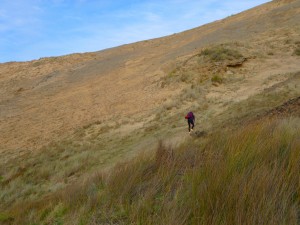 Geographical Positioning and Sartorial X-Factor had a lovers’ tiff. We found ourselves somewhere on the dune, without a trail marker in sight. The path had simply disappeared. After ignominiously sliding around, clutching at dune grass and doing a lot of vituperative whining, we eventually found the marker post we had missed and laboured to the summit. In the distance we could see Shire-like green farmland.
Geographical Positioning and Sartorial X-Factor had a lovers’ tiff. We found ourselves somewhere on the dune, without a trail marker in sight. The path had simply disappeared. After ignominiously sliding around, clutching at dune grass and doing a lot of vituperative whining, we eventually found the marker post we had missed and laboured to the summit. In the distance we could see Shire-like green farmland.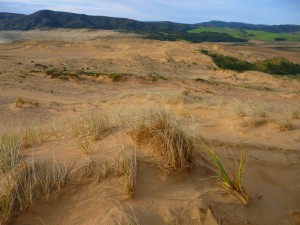
With the light fading, we wanted to get to the campsite at Twilight Beach so pressed on. We found the beach but set up our tent on a dune, because the camp was nowhere in sight. “I’m ready to go home now,” announced Hannah as we chewed our reconstituted freeze-dried beans. Then: “I can hear footsteps.” As ex-pat South Africans, we still occasionally lapse into paranoia, but Hannah sometimes has auditory hallucinations due to her anxiety. I switched off the light so my ears could work better but I couldn’t hear anything sinister, just the waves breaking. We are accustomed to Auckland’s east coast sea, which is rather polite. The west coast sea, on the other hand, is vulgar and noisy. By 8.00 pm I was longing for a bit of peace and quiet. I felt a spiritual moment coming over me. “The ceaseless surf sounds like a huge cosmic toilet, eternally flushing,” I said to Hannah. “The only reason I don’t disown you totally, Mom,” she replied, hunching her shoulder under her sleeping bag, “is because you make comments like that.”
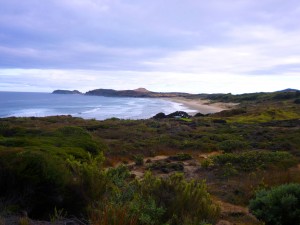 Friday 19 July
Friday 19 July
Twilight Beach through Scott Point to The (local) Bluff (30 km)
We bickered over who was going to wash the billy in the sea as opposed to rolling up the mattresses. Hannah won the billy and managed to achieve wet trouser legs. After 2 km we discovered the campsite we were meant to have reached the night before. You can see it (almost centre) in this picture, taken looking back the way we came. At 10 o’clock to the camp, you can see the wee pimple which was yesterday’s massive dune. We filled a bottle from the rainwater tank, and used the Steripen for the first 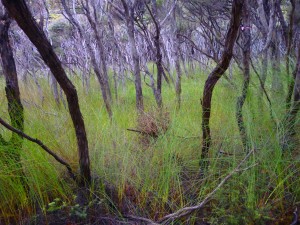 time. It blitzes bacteria, protozoans and every other form of evil with ultraviolet light. All you need to do is insert it into the water, press a button and wait for 60 seconds. I can think of a few people who could be improved in this way. Charles Manson, for example. But I don’t know if he’d hold still long enough after the insertion.
time. It blitzes bacteria, protozoans and every other form of evil with ultraviolet light. All you need to do is insert it into the water, press a button and wait for 60 seconds. I can think of a few people who could be improved in this way. Charles Manson, for example. But I don’t know if he’d hold still long enough after the insertion.
Scott’s Point is shrubby and scrubby with very dense vegetation. The path is badly eroded in some 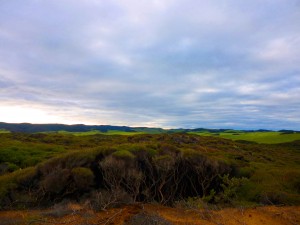 places, but at least this meant we were in no danger of losing our way.
places, but at least this meant we were in no danger of losing our way.
We were thrilled to see Marius, Etienne and Zoë walking to meet us on the track. However, the news wasn’t all good: they had camped the night before 58 km south of where we were now, but the car had made ominous clunking noises indicative of wrecked shocks just as they arrived at Hukatere Lodge. My heart sank. How were we to afford replacing shocks, now that I had resigned from my job to walk with Hannah?
But there were two treats in store. Our beloved Zoë was going to walk with us from now on, and the blokes had got a lift up to the beginning of 90-Mile Beach, just below Scott Point, with Uncle. “He is a lovely old Maori bloke with an interesting face and the most amazing hair,” said Marius. (Amazing hair always interests me. The other day I saw a teenager with a wedge haircut, the top part dyed dead black and the short back and sides orange. He looked like a lost but ambulatory liquorice allsort searching for his packet.) Well, Uncle’s hair is indeed amazing: white, outstanding and entirely natural; his personality is gorgeous and his stories entertaining. He gave us a litre of ginger beer to bolster our fluid supply for the next 25 km, which was what we had to walk that afternoon to reach The Bluff, the next campsite. We could manage that distance without the backpacks, which Marius and Etienne would take now, then set up camp and wait for us.
Something you ought to know is that 90-Mile Beach is actually 55 miles long. A fisherman must have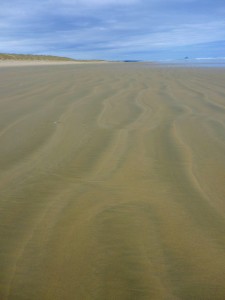 named it. We contemplated what lay ahead. These three pictures give you some idea. The interesting landscape was overs kadovers behind us. In front of us was this: l-o-o-o-n-g, w-i-i-i-d-e, featureless beach. To the left, nothing but dunes of varying height but unvarying character.
named it. We contemplated what lay ahead. These three pictures give you some idea. The interesting landscape was overs kadovers behind us. In front of us was this: l-o-o-o-n-g, w-i-i-i-d-e, featureless beach. To the left, nothing but dunes of varying height but unvarying character. 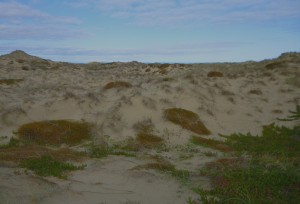 To the right, nothing but the Tasman Sea. No, I lie. There is Matapia Island, a few kilo-metres offshore, which has a massive hole through it. Excitement about the hole dribbles away after a few hours on the hoof, though. But Zoë was mad with joy. Being out
To the right, nothing but the Tasman Sea. No, I lie. There is Matapia Island, a few kilo-metres offshore, which has a massive hole through it. Excitement about the hole dribbles away after a few hours on the hoof, though. But Zoë was mad with joy. Being out 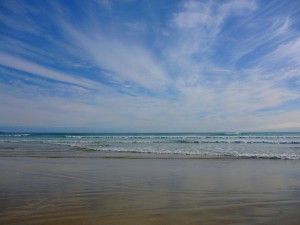 doing walkies all day and sleeping between two of her human pack all night is clearly the most marvellous thing in the world. She exchanged her normally shy and retiring behaviour for dizzy prancing and idiotic circling.
doing walkies all day and sleeping between two of her human pack all night is clearly the most marvellous thing in the world. She exchanged her normally shy and retiring behaviour for dizzy prancing and idiotic circling.
So we walked…. As dusk approached, we got nervous. There is nothing along the beach to indicate how far you have travelled. You assume you’re doing about 4 or 5 km per hour, but it is hard to know for sure. I had GPS on a borrowed i-phone, but there was no cell phone reception, hence no Internet connection essential for this particular GPS to work. If we were far short of the campsite, or had passed it, we’d have to spend the night without a tent or sleeping bags on the dunes. This Gretel and Gretel scenario did not appeal. Uncle had made a donut with his truck to mark the sand next to the dune behind which the campsite lay, but the beach has quite a lot of traffic. Hannah’s ankles and soles were troubling her again and my body had passed its “best before” moment for the day, too. Just as our bottom lips started to quiver, we saw a dark blob ahead, which divided into two blobs. It was Marius and Etienne cycling to intercept us. The relief was immense. If we were all Zoës we would have been wagging, licking, piddling and sniffing botties like billy-ho. The good news was that the car was fixed, without an expensive replacement of shocks, just a loose bolt dealt with for a mere $40, and the tents were up and waiting for us only 1 km ahead.
After dinner we read Adrian Mole aloud to each other for half an hour and then it was almost instant coma for all, despite the continued perfect functioning of the cosmic toilet.
Saturday 20 July
The Bluff to one-and-a-half dead seals 9 km short of Hukatere (21 km)
I woke up feeling grim: aching from the previous day’s walk and sticking to my sleeping bag due to not having washed since Wednesday. Warning: parental guidance is recommended for the following details. Sluicing off was essential, but the facilities were distressingly crude. Using the dishcloth and the dog’s bowl of water I gave myself a wash in the tent. The bliss! I could not help but make loud oohs and aahs of relief. Despite there being no-one else within sight or hearing, the children were disgusted and embarrassed. Teenagers are terribly sensitive and easily damaged, you know. Etienne pretended to retch and Hannah said “Mom, kindly stop making those grunts of euphoria!” The only reason I don’t disown my daughter totally is because she makes comments like that.
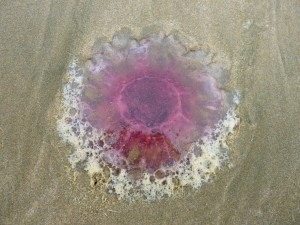 This day of walking was dull. The view was unchanged and we saw no living marine mammals so we transferred our attention to the ground. The tide had left a large range of sea sponges. We entertained each other by speculating which sponge was most suited to which celebrity’s bathtime. There was a black one which we thought would do as Cruella de Vil’s ablution accessory. We saw a lot of bluebottles and some peculiar raspberry red jellyfish, which we didn’t want Zoë to step on. We
This day of walking was dull. The view was unchanged and we saw no living marine mammals so we transferred our attention to the ground. The tide had left a large range of sea sponges. We entertained each other by speculating which sponge was most suited to which celebrity’s bathtime. There was a black one which we thought would do as Cruella de Vil’s ablution accessory. We saw a lot of bluebottles and some peculiar raspberry red jellyfish, which we didn’t want Zoë to step on. We 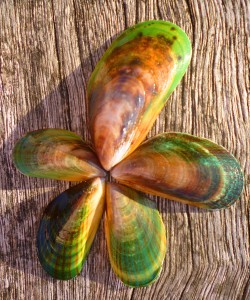 picked up pumice stones – there was an abundance of these – enough to soften and titivate the cracked feet of all Africa’s elephants to the point of powder puffhood. We also found green mussel shells, something we’d never seen before. Uncle told us that night that the green-lipped mussel is big business on 90-Mile Beach and was what all those truck drivers with trailers were after. Ah. Now we know. We collected a pile of these
picked up pumice stones – there was an abundance of these – enough to soften and titivate the cracked feet of all Africa’s elephants to the point of powder puffhood. We also found green mussel shells, something we’d never seen before. Uncle told us that night that the green-lipped mussel is big business on 90-Mile Beach and was what all those truck drivers with trailers were after. Ah. Now we know. We collected a pile of these 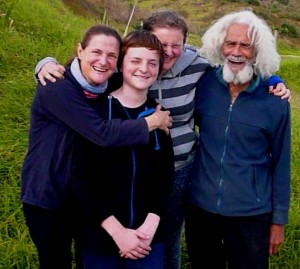 beautifully coloured shells to add to our mermaid’s mirror.
beautifully coloured shells to add to our mermaid’s mirror.
We decided not to push the mileage, so after a few hours, Marius and Etienne came in the car to fetch us where we were waiting upwind of one-and-a-half dead seals. The odometer showed we were 9 km short of Hukatere Lodge.
We ate dinner with Uncle (you can see his amazing hair in this picture); he said grace for us in te reo and gave Hannah and me a foot massage.
Sunday 21 July
One-and-a-half dead seals to 9 km short of Waipapakauri Beach (17 km)
Gloom! We were dropped off at the previous afternoon’s pick-up point to cover our lost distance. Zoë, a squirming joyball, did her symbolic bit for Hannah by carrying the thing in her doggie vest pocket. After wriggling down a dune on her back, Zoë got the extremely fine, caster sugar-like sand up her nose and did some spectacular sneezes, resulting in the bottle falling out (of the pocket, not her nose). Luckily we noticed, or we would have had to go back to Te Werahi Beach. Being with Zoë makes us feel cheerful. How often have you pressed yourself against a friendly cat, dog or horse and felt comforted and more peaceful? Even a hamster can help. Today, Zoë was nobly walking for all pets helping people heal from mental illness.
Plenty of tour buses passed us on the beach. People want to see the area en route to the lighthouse, but not many want to do so on foot. We didn’t see any other serious trampers for the full five days and we were possibly the only mammals the tourists saw.
We were delighted to find two hermit crabs in their shells. One was teeny, and we could just see his bigger 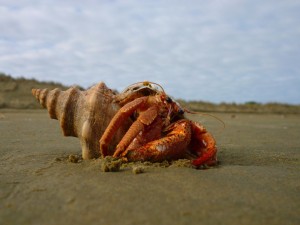 claw peeping out. His shell had a huge barnacle on it, like a chimney stack. The other crab, from shell tip to claw tip was about the size of my hand. He seriously needed a new shell because most of him was hanging out of his front door. I’m sure Housing New Zealand would be sympathetic to his application if he doesn’t get run over before reaching the top of the priority list.
claw peeping out. His shell had a huge barnacle on it, like a chimney stack. The other crab, from shell tip to claw tip was about the size of my hand. He seriously needed a new shell because most of him was hanging out of his front door. I’m sure Housing New Zealand would be sympathetic to his application if he doesn’t get run over before reaching the top of the priority list.
With the 9 km complete, we continued south towards Waipapakauri Beach, but having got out of synch with the campsites, we again stopped 9 km short of our 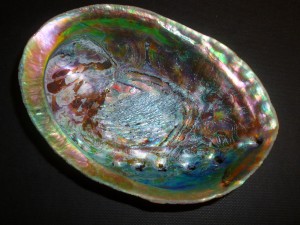 destination and were fetched in the car, clutching our major find of the day, a pāua shell. We are soon going to have to accustom ourselves to roughing it and camping where we stop instead of being chauffeured and pampered by enslaved relatives during their school holidays.
destination and were fetched in the car, clutching our major find of the day, a pāua shell. We are soon going to have to accustom ourselves to roughing it and camping where we stop instead of being chauffeured and pampered by enslaved relatives during their school holidays.
Monday 22 July
Nine km short of Waipapakauri Beach to Ahipara (24 km)
Oh goodie gum drops: our last day of the leg! We could see, very faintly in the distance, where Ahipara lay in the curve of the coast. Hannah’s ankles had been whimpering for the last two days, and what with that and the timing of the tide, we decided that she would do the missing 9km on Etienne’s bicycle, accompanied by Marius and Zoë. Etienne and I dropped them at the previous afternoon’s pick-up point and returned to wait for them at Waipapakauri Beach. Although driving on the beach is legal here, I don’t enjoy it. Coming from a country where beach driving is frowned on because of the fragile indigenous flora and fauna, I still feel guilty.
Hannah and I walked the last 15 km together, with Zoë again being the thing bearer for the day. We saw a 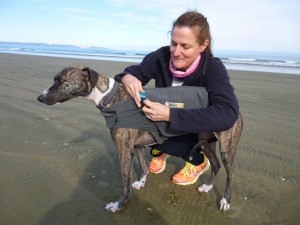 seal, the first live native mammal of the leg. It was working its way across a very long stretch of sand from the high tide mark down to the retreating water. Laboured heavings were punctuated by long periods in a bug-eyed prone position. I know just how it felt.
seal, the first live native mammal of the leg. It was working its way across a very long stretch of sand from the high tide mark down to the retreating water. Laboured heavings were punctuated by long periods in a bug-eyed prone position. I know just how it felt.
One hour’s walk away from Ahipara, a miracle happened: cell phone reception was restored. Hannah was busy texting from that point onwards, all the way home in the car to Auckland.
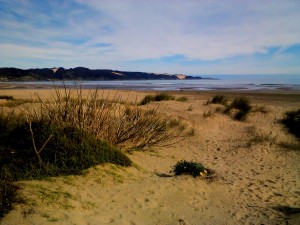 Ahipara (at 9 o’ clock in this picture) is where we shall return to start the Herekino Forest leg of the trail. Ideally, we’d prefer to walk each trail section consecutively, but we’ll do other sections first because Herekino is better attempted in dry weather. As it turned out, we were extremely fortunate with the weather on 90-Mile Beach. It was overcast and cool and we had a light breeze instead of a howling, sand-whipping, motivation-sapping headwind.
Ahipara (at 9 o’ clock in this picture) is where we shall return to start the Herekino Forest leg of the trail. Ideally, we’d prefer to walk each trail section consecutively, but we’ll do other sections first because Herekino is better attempted in dry weather. As it turned out, we were extremely fortunate with the weather on 90-Mile Beach. It was overcast and cool and we had a light breeze instead of a howling, sand-whipping, motivation-sapping headwind.
Zoë did not want to come home. She has decided that her role is that of Bounteous Beach Bitch: the Dune Dog Imperial and Wave Warrior. She declined to get into the car, despite our seductive cooings, and tried to return to the beach with another family that walked past. We hoped that her holiday would effect a permanent bouncy change in her; at home, she lies all day on a velvet bed in front of the TV, or when she’s feeling sensitive, she retreats to the cupboard where she sleeps on Marius’s shoes. But it was not to be… the moment she got through the front door, she slunk sadly to her bed. What is it with humans? They take you to heaven and then they bring you straight back? Pffft!
